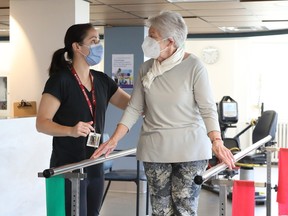Bruyère hospital’s geriatric day program is transforming the lives of seniors at risk of falls and isolation.

Article content
Mildred Breault carefully steps on to a balance platform and raises her hands above her head. On either side of her are parallel bars if she needs them for support. Nearby is a physiotherapist urging her on for additional support.
The balance work is part of Breault’s twice-weekly routine as a patient at Bruyère’s geriatric day hospital. Without hesitation, the 78-year-old says the program has transformed her life by helping her become stronger and steadier and regain her confidence. Its aim is to keep people like Breault healthy and independent for as long as possible.
Advertisement 2
Story continues below
Article content
Article content
The retired high school principal and world traveller, who once spent a solo year travelling across Africa, was thrown for a loop on a recent trip to Mexico when she began experiencing falls.
“I hadn’t fallen for years,” she said. But in a period of months during travel with her brother, she fell four times. She was not seriously injured, but she was worried. The falls made her increasingly cautious and she began to question her abilities.
“I had travelled a lot and I just sort of saw that slipping away,” said Breault. “I didn’t know what I was going to do with myself.”
Falls are common for people over the age of 65 and can be devastating. Even when they don’t cause serious physical injury, which they frequently do, they can mark the start of a downward spiral that can quickly be exacerbated by lack of confidence and fear, and can negatively affect physical and mental well-being.

Bruyère’s John and Jennifer Ruddy Geriatric Day Hospital, one of a network of specialized geriatric services in the region, is an inter-professional rehabilitation program designed to help and support people at risk before something more serious happens and they end up in a hospital bed. Doctors, physiotherapists, occupational therapists, recreational therapists, social workers and more help patients remain active and engaged in their lives.
Advertisement 3
Story continues below
Article content
At a time when thousands of often elderly patients are in hospital beds while they wait for a long-term care bed or home care, programs like Bruyère’s serve a growing need.
“I think what is nice is that we are often able to catch people before the big thing happens,” said Dr. Veronique French, chief of care of the elderly and a physician at Bruyère. “That part is really amazing, to feel like you have sort of changed their trajectory.”
Social isolation, deconditioning, medication and more can affect the ability of some elderly patients to function well. By addressing individual issues and concerns, the program can help improve patients’ quality of life, she said.
“We are looking at the whole person,” said French. “We see everybody here from retired cabinet ministers to refugees to residential school survivors. It is really interesting to think about how we are going to modify and adapt (treatments and therapies) to make sure that we are meeting the specific needs of the person in front of us.”
Among the program’s focuses is reducing the number of medications patients are on, when possible.
Advertisement 4
Story continues below
Article content
Just getting to the program twice a week can be a first step toward a better quality of life for some patients, said French, because it can break a cycle of social isolation, fear and deconditioning. Staff members help arrange transportation to make it easy for patients to get to their appointments.
Once patients are there, therapies and meetings aimed at improving confidence in walking are key, said Dr. Anne Monahan, who is a staff physician at the geriatric day hospital.
By focusing on exercises that build strength and confidence in patients, making them more mobile, Monahan said, the program also takes aim at the ripple effects of losing that confidence, such as decreased activity in the community and mood, which can lead to social isolation.
“What we offer is really a co-ordinated effort as a team to bring them along to recognize that, yes, they do have deficits, that maybe they can’t accomplish the things in their daily lives that they used to be able to do, but there is still hope. We give them hope, we give them a sense that they are being listened to and we’re understanding their problems,” said Monahan.
Advertisement 5
Story continues below
Article content
“That often leads to this kind of magical transformation, which is not easily measured but which tends to shine through in some of the testimonials that we hear from people. In some cases, it can be quite remarkable.”
Breault, who lives independently in the home she has long shared with her brother, is among patients who have experienced that kind of transformation during the eight-week program.
“It has given me my life back,” she says.
Our website is your destination for up-to-the-minute news, so make sure to bookmark our homepage and sign up for our newsletters so we can keep you informed.
Recommended from Editorial
Article content


Comments